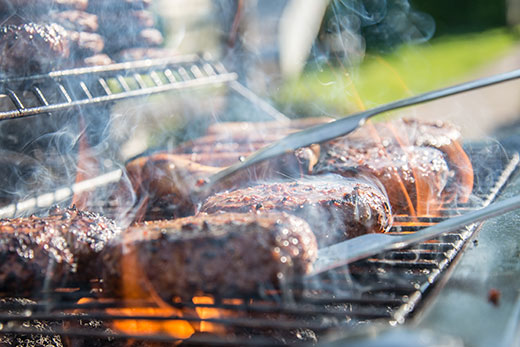
Food safety specialist Karen Blakeslee says color is not an indication of meat doneness. Use a food thermometer and cook foods to the recommended internal temperature.
Time to Grill? Think food safety first, says K-State expert
As BBQ season begins, a food thermometer can be a best friend
May 21, 2020
MANHATTAN, Kan. – Home cooks often hail Memorial Day as the beginning of grilling season, which leads Kansas State University food safety specialist Karen Blakeslee to suggest they buddy up with a familiar kitchen utensil.
“A food thermometer should be your best friend,” said Blakeslee, coordinator of the university’s Rapid Response Center. “You should never determine meat doneness based on color. Use a food thermometer and make sure meat is cooked to the recommended minimum internal temperature.”
For the three most common types of grilled meats, those recommendations include:
- Steaks, chops and roasts – 145 degrees Fahrenheit.
- Ground meat – 160 F.
- All poultry – 165 F.
Blakeslee said a food thermometer should be inserted into the center of the thickest part of the meat, away from bone, fat and gristle. For ground meat – such as hamburger patties – insert into the side so that the thermometer is positioned through the center of the food.
“There are many types of thermometers to choose from when cooking,” Blakeslee said. “For checking food temperature, a digital or dial food thermometer is best. Digital temperatures can sense temperature at the tip of the probe and give a quick temperature response.”
She cautioned that digital thermometers cannot be left in the food during cooking.
“Other food thermometers have a temperature probe connected to a separate digital display. If grilling, use one designated for the high heat of grilling. For large cuts of meat – such as roasts – a meat thermometer can be inserted into the roast and left in during cooking.”
Blakeslee lists several other food safety tips as folks gear up for outdoor grilling:
- Use separate plates and utensils for raw meats and cooked meats.
- Keep hot foods hot and cold foods cold. Hot foods should be maintained at a temperature above 140 F, while cold foods should be kept below 40 F.
- Wash your hands frequently, especially after handling raw foods, before and during meal preparation, and before eating.
- Prepare several ice chests to keep food cold and to separate items. Keep beverages in one chest, ready-to-eat foods in another, and raw meats in a third.
- Do not wash meat or poultry before cooking. “This increases the chance for cross-contamination and is not necessary,” Blakeslee said. “Cooking meat to the proper internal temperature is your best defense.”
Some non-food safety tips include positioning the grill away from flammable areas, checking the charcoal or gas supply so you don’t run out while preparing meals, and keeping children and pets away from a hot grill.
Blakeslee said K-State Research and Extension has published a comprehensive guide to safe food handling, title ‘At-Home Safe Food Handling: It’s in Your Hands.’ The publication is available for free through the K-State Research and Extension bookstore.
Blakeslee and other K-State food safety specialists also maintain a website with food safety tips for grilling, tailgating and picnics.
“Plan ahead to keep the party simple,” Blakeslee said. “If you are having guests over, ask them to bring other menu items or supplies such as utensils, plates and beverages. The main goal is to have fun.”
